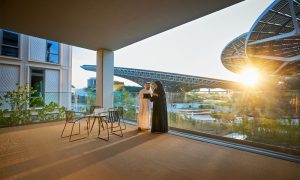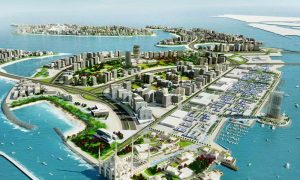Healthy demand for hospital construction in the Gulf
How the complexities of building hospitals have changed over the years

Amidst the glitz and glamour of shopping malls and luxury hotels coming up in the GCC, it’s easy to lose sight of the less exciting but equally important infrastructure the region will need to sustain its growing population. Increasing urban development, combined with sedentary lifestyles and the associated health risks, have created a significant need for more hospital beds in the Gulf region.
According to a report last year by Alpen Capital, the GCC’s healthcare market is projected to grow at a rate of 12% per annum to $69.4 billion by 2018, with Saudi Arabia expected to be the largest market, followed by Qatar and the UAE. Countries like the UAE are also keen on positioning themselves as medical tourism destinations, acting as a further driver for healthcare growth and investment.
But as governments look at building more medical facilities in the region, it’s worth taking a look at what challenges remain for contractors and consultants when working on healthcare projects, and how hospital design and construction is evolving.
According to Simon Bourke, director of healthcare at engineering consultancy BuroHappold, one of the key factors behind the complexity of hospital projects is that there are often several stakeholders involved. This can lead to a lengthy briefing period and approvals process, and part of the challenge is getting the “right decisions made at the right time”.
BuroHappold addresses this, he notes, by briefing the client on the architecture and engineering aspects of the project at the same time, so as to get approval in advance for both. “Sometimes the clients can understand the architecture much easier than they can understand engineering.” To deal with this, the firm sets up dedicated briefing sessions to take the client through the engineering aspects in a user-friendly way.
Bishoy Azmy, CEO of Al Shafar General Contracting, agrees that hospitals require considerable coordination across hospital staff, design and construction teams. “The healthcare construction industry is complex, and shareholder and patient requirements often necessitate that projects are completed faster.” Moreover, planning processes are more complicated and must account for the intricate nature of healthcare facilities, he says.
The fact that several stakeholders are involved also means accounting for differences in culture and experience, while also trying to tackle unrealistic schedules, points out Martin Mcintire, head of healthcare – Middle East at Arcadis.
Working around equipment
Stakeholders aside, the engineering complexity, technical requirements and, of course, ultra-expensive equipment associated with hospitals definitely bring their own share of challenges, the experts agree. To start with, there are massive differences across departments, some more engineering-driven than others, Bourke says. “You have obviously the very acute critical areas like theatres and intensive care. You have to have very defined conditions, and you design for those.”
Other areas like diagnostics and radiology are more driven by equipment providers. Because diagnostics and equipment are evolving so rapidly, an especially important aspect of hospital design now is future-proofing the facility, so that it can adapt to changing technologies. “It’s quite challenging in terms of how you make the building flexible enough to ensure it’s not obsolete by the time you’ve actually finished constructing it.”
Azmy also echoes Bourke’s comments on the importance of future-proofing. “The growth of technology in the healthcare industry requires the construction of facilities that are adaptable and flexible in the long term and can easily accommodate new technologies that enter the industry.”
Moreover, MEP coordination is particularly difficult and requires a more detailed and calculated approach compared to construction in other projects, because building services and systems have to be designed around the equipment in hospitals, further complicating the process.
For instance, high-tech rooms like operating theatres and ICU wards may contain medical equipment fixed to the walls, ceilings or floors and requires dedicated building services such as medical gases, power supply and IT connectivity. This means rooms cannot easily be redesigned and equipment can’t be moved around with the same ease that an office building can move desks and chairs, he points out. “Careful planning and decisions must be made at early stages and they cannot change later in construction, or at least not without severe consequences to the project being completed on time.”
The extensive planning around sophisticated medical equipment necessitates working closely with equipment providers. But even when one factors in the main considerations, it’s easy to get the little things wrong, Bourke admits, like installing the power supply in the wrong place for the machines.
The solution to this technology overdose is unsurprisingly more technology, namely BIM. Equipment providers can coordinate with architects and engineers over the service requirements for the equipment through a BIM model, Bourke says.
“The whole idea of BIM will be a massive benefit to the industry. We can ensure that from the equipment sheet all the way through to the installation drawings and the servicing requirements, it can all be coordinated more effectively.”
The evolution of hospital design
While contractors and consultants may certainly appreciate the challenges of building and delivering healthcare projects, this is probably of little concern to the people these developments are built for: the patients. Visiting the hospital is never an enjoyable process – how can medical facilities be built to provide a more nurturing and perhaps cheerful environment for patients to recuperate in?
Creating an environment focused on patient well-being as opposed to just getting technical aspects right is where healthcare design is headed at the moment, says Dr Nasser B Abdulhasan, principal of Kuwait-based AGi Architects. The technical and engineering complexity that’s part and parcel of hospital design means a very extensive set of guidelines has been developed, particularly in the US and UK. However, all standards and no creativity make a hospital a dull place, and following the guidelines to a T would inevitably make medical facilities everywhere look exactly the same, he notes.
“It’s actually like taking bits and pieces of an equation and plugging them together and building a facility out of it,” he says. For this reasons, hospitals historically may have been technically good facilities but they simply did not factor in human needs. “We have to really find a middle ground in understanding what best practice is for various types of hospitals.”
Healthcare design is now much more about the human element, Abdulhasan stresses. He mentions a cardiac centre in Kuwait that his firm is working on, where the main driver is for patients to not feel like they’re in a hospital environment. This is done by offering facilities such as a gym for rehabilitation, cooking and nutrition classes, and public spaces in the facility to better enable doctor-patient interaction in a relaxed environment.
Mcintire also notes the increased focus on the patient at the centre of healthcare design, with comfort of patients driving many design elements in modern hospital rooms. “Everything from holistic, hotel-like interior designs and amenities, to family sitting areas with access to television entertainment and internet access.” Even elements that aren’t as visible, such as sound-masking technology in patient area corridors, can help enhance comfort, he adds.
Much of this is driven by the fairly recent concept of the patient as a consumer with the desire and ability to control their environment, as opposed to an invalid confined to bed, Bourke says.
Ultimately, however, what’s undeniable across the board is that hospitals have become more than just a place to treat illness.
“It’s not just about getting your treatment, it’s actually about everything that is pre and post getting the treatment,” Abdulhasan says. “Nobody who goes to the hospital is happy [about it]. The environment has to be fulfilling from both the staff’s point of view and the patients’ point of view. That’s the only way for a hospital.”
Accounting for cultural factors in design
Healthcare design in the Middle East needs to take into account cultural factors, such as higher numbers of people visiting patients compared with other parts of the world, Bourke and Abdulhasan say.
Although many aspects of hospital design, such as the size of operating theatres and diagnostic spaces, do not differ much across countries, this isn’t the case for patient bedrooms and some other areas, Bourke says.
“As an international engineer, you have to be very attuned to specific cultural requirements,” he says, adding that in places like the Middle East and the Indian subcontinent, the idea of the extended family is extremely important. One can thus typically expect higher numbers of visitors on average, which in turn affects aspects of hospital design, such as the size of bedrooms or elevators.
“You could get it badly wrong if you’re only expecting two or three visitors per day and actually you might be getting eight. It could end up with big queues in the lobbies to get through up to the in-patient areas, so things like that you have to be very sensitive to,” Bourke says.
Abdulhasan echoes Bourke’s comments about the importance of factoring in culture. “If someone is [having] surgery, there’s a much larger number of family members waiting outside for as many hours as needed because the society functions in that fashion, and that has to be addressed in any design.”
Hospital design guidelines, which have been extensively developed in countries like the US and UK, do not factor in cultural requirements, Abdulhasan and Bourke note. “If you’re using, for example, UK or American regulations for the Middle East, you have to be conscious of some of the thoughts behind those regulations and why they may need to be adapted,” Bourke says.
Preventing the spread of infections
Infection control is undoubtedly a vital aspect of healthcare design, and the industry is now developing new means to prevent the spread of disease. “While hospital environmental services departments continually strategise and provide physical processes of cleaning, it’s nice to see many of the leading medical equipment and furniture/interiors manufacturers have jumped in to support the cause,” Mcintire says.
Many products are now manufactured with antimicrobial materials that deter germs. Product designs are ensuring to eliminate cracks, crevasses and other elements that could otherwise become a source for gathering of germs or be difficult to clean.
Additionally, air exchange systems to get rid of dirty air have become a lot more sophisticated, and there is now also a big move towards single-bed rooms instead of multi-bed wards to prevent infection, Bourke says.
However, even with all the design elements in place, there’s no discounting the importance of healthcare providers in preventing the spread of disease. Ensuring staff pay adequate attention to hygiene is also crucial, Bourke points out.
“It’s a combination of design, engineering systems and also the staff within the building that contribute to infection control.”

















